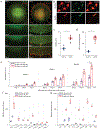A 3D human triculture system modeling neurodegeneration and neuroinflammation in Alzheimer's disease
- PMID: 29950669
- PMCID: PMC6800152
- DOI: 10.1038/s41593-018-0175-4
A 3D human triculture system modeling neurodegeneration and neuroinflammation in Alzheimer's disease
Abstract
Alzheimer's disease (AD) is characterized by beta-amyloid accumulation, phosphorylated tau formation, hyperactivation of glial cells, and neuronal loss. The mechanisms of AD pathogenesis, however, remain poorly understood, partially due to the lack of relevant models that can comprehensively recapitulate multistage intercellular interactions in human AD brains. Here we present a new three-dimensional (3D) human AD triculture model using neurons, astrocytes, and microglia in a 3D microfluidic platform. Our model provided key representative AD features: beta-amyloid aggregation, phosphorylated tau accumulation, and neuroinflammatory activity. In particular, the model mirrored microglial recruitment, neurotoxic activities such as axonal cleavage, and NO release damaging AD neurons and astrocytes. Our model will serve to facilitate the development of more precise human brain models for basic mechanistic studies in neural-glial interactions and drug discovery.
Conflict of interest statement
Competing Financial Interests Statement
The authors declare no competing interests.
Figures






Comment in
-
Modeling Alzheimer's disease brains in vitro.Nat Neurosci. 2018 Jul;21(7):899-900. doi: 10.1038/s41593-018-0177-2. Nat Neurosci. 2018. PMID: 29950667 No abstract available.
References
-
- 2016 Alzheimer’s disease facts and figures. Alzheimer’s & Dementia 12, 459–509 (2016). - PubMed
-
- Tanzi RE & Bertram L Twenty Years of the Alzheimer’s Disease Amyloid Hypothesis: A Genetic Perspective. Cell 120, 545–555 (2005). - PubMed
-
- Karran E & De Strooper B The amyloid cascade hypothesis: are we poised for success or failure? Journal of Neurochemistry 139, 237–252 (2016). - PubMed
-
- A Armstrong R A critical analysis of the ‘amyloid cascade hypothesis’. Folia Neuropathologica 3, 211–225 (2014). - PubMed
-
- Paquet D et al. Efficient introduction of specific homozygous and heterozygous mutations using CRISPR/Cas9. Nature 533, 125–129 (2016). - PubMed
Publication types
MeSH terms
Substances
Grants and funding
LinkOut - more resources
Full Text Sources
Other Literature Sources
Medical
Molecular Biology Databases

